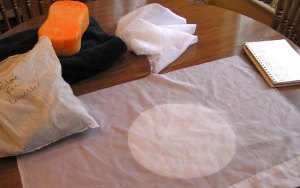Influencing Shape with Prefelt Part 2
I finally got around to trying a different shaped pod using prefelt to influence the shape. My first post creating a seed pod is here. I created this pod in the same way but started with a different shape and cut the prefelt differently. I decided to use a bit brighter color for the inside layer.
I used the same green batt that I had used on my last pod but used a tear drop shaped resist. I covered the resist and felted until it was holding together to make a prefelt.
I then cut a little cap off the top and a diagonal type cut all the way down to the end. The photo on the left shows the “front” side and the photo on the right is the “back” side.
I then took the green prefelt off the resist and covered it with orange wool and wet the orange wool down. Then I put the green prefelt back over top of the orange wool. I wrapped the orange wool around the resist from side to side. Next time, I think I would wrap it from end to end to get a more defined shrinkage but it worked this way too. The orange layer is fairly thin compared to the thicker green prefelt.
I then began felting the two together. I carefully rubbed along all the green edges and worked on getting the edges to stick down to the orange underneath. Once everything was holding together, I removed the resist. Then I fulled the piece and rubbed along the orange lines to get the resulting shape. I fulled it very hard so it would hold its shape easily.
And here’s the result. It does look very much like a seashell but also could be a chili pod or some other sort of veggie pod. These are really fun to make, have you tried this technique yet? Please show us your results over on the forum.















































